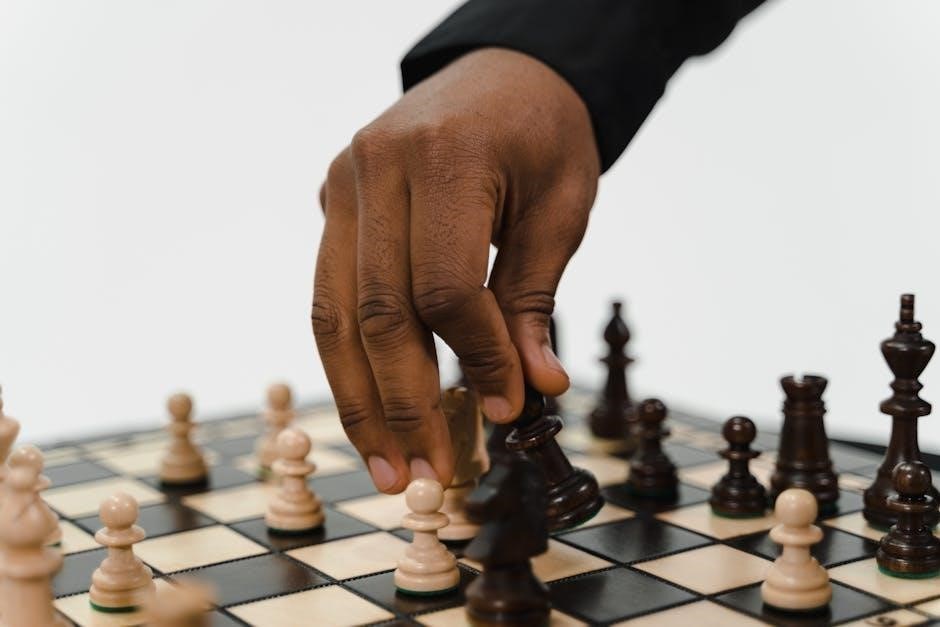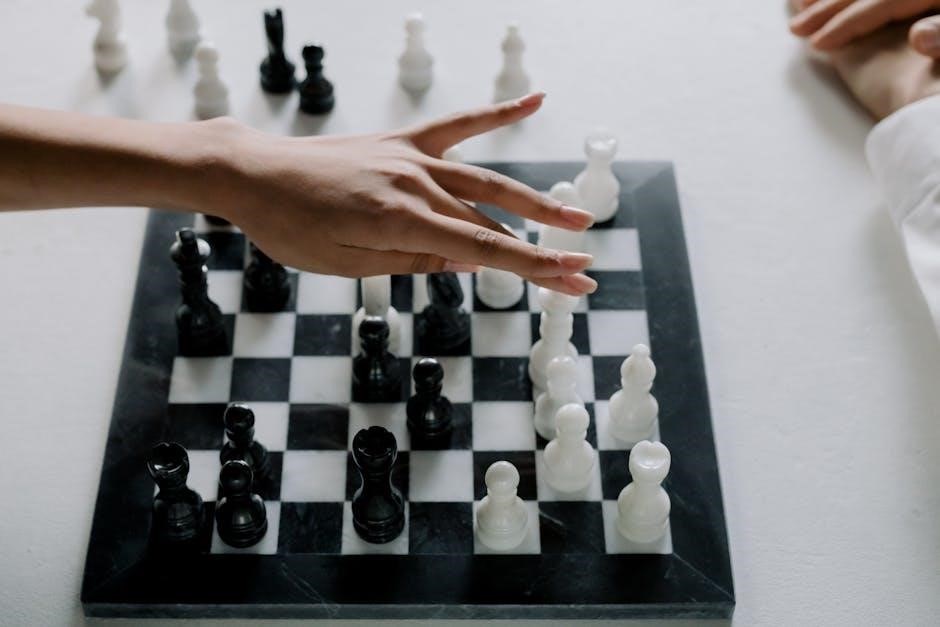Chess is a blend of skill and strategy, requiring players to master essential principles for success. This guide will explore key techniques to enhance your gameplay and increase your chances of winning, catering to both beginners and experienced players.

Understanding the Basics of Chess
Mastering the fundamentals is crucial for success in chess. Learn how each piece moves, the board setup, and the ultimate goal of checkmating your opponent.
2.1. The Chessboard and Pieces
A standard chessboard consists of 64 squares arranged in an 8×8 grid, alternating between light and dark colors. The board is divided into ranks (rows) and files (columns), with each square identified by a unique coordinate. The pieces are placed on the first and eighth ranks, with the white and black pieces facing each other. The back rank for each player features the major pieces: a rook, knight, bishop, queen, king, bishop, knight, and rook. Pawns occupy the second and seventh ranks. Understanding theboard layout and piece placement is essential for executing moves effectively.
2.2. Basic Rules and Objectives
The primary objective in chess is to checkmate the opponent’s king, rendering it unable to escape capture. Players take turns moving one piece at a time, with white moving first. Each piece has unique movement rules: pawns move forward, knights jump in an L-shape, bishops diagonal, rooks straight, queen combines rook and bishop, and king moves one square in any direction. Legal moves must be made to avoid placing the king in check. The game ends when a king is checkmated, a player resigns, or a draw is agreed upon or enforced by rules like stalemate or insufficient material.

Building a Strong Foundation
Building a strong foundation in chess involves mastering essential principles like controlling the center and rapid piece development. These elements ensure stability and create opportunities for decisive attacks later in the game.
3;1. Opening Principles
Mastering opening principles is vital for a strong start. Focus on controlling the center with pawns and pieces, ensuring rapid development, and maintaining a flexible pawn structure. Avoid unnecessary pawn moves and develop minor pieces toward the center. Protect your king by castling early and avoid weaknesses on the kingside. Understanding these principles helps you establish a solid position, creating opportunities for a successful middlegame. While memorizing specific openings can be useful, prioritizing fundamental concepts ensures long-term improvement and adaptability in various situations.
3.2. Pawn Structure and Management
Pawn structure is the backbone of any chess position, influencing mobility and control. Proper management involves maintaining flexible pawns, avoiding weak squares, and supporting key outposts. Pawn chains can either strengthen your position or become a liability if overextended. Understand when to push pawns for space and when to hold back. Liquidating pawns to create passed pawns can be decisive. Conversely, defending pawns requires careful planning to prevent them from becoming targets. Effective pawn management balances aggression with stability, ensuring your position remains resilient and poised for strategic opportunities.

Strategic Planning and Positional Play
Strategic planning in chess involves creating long-term plans and coordinating pieces. Focus on controlling the center, piece activity, and prophylactic thinking to outmaneuver opponents and achieve lasting advantages.
4.1. Understanding Key Concepts
Mastering strategic planning begins with understanding key positional concepts. Control of the center, piece activity, and pawn structure are foundational. Prophylactic thinking, anticipating opponents’ plans, is crucial. Space advantage and minority attacks can dictate the flow of the game. Open lines and strong outposts provide mobility and attacking chances. Transitioning smoothly from the middlegame to the endgame is vital. These principles guide long-term planning, enabling players to outmaneuver opponents and create lasting advantages. Applying these ideas consistently leads to a more structured and effective positional play.
4.2. Long-Term Planning
Long-term planning in chess involves setting strategic goals and shaping the position to achieve them. This includes maneuvering pieces to strong squares, creating pawn structures that support your strategy, and preparing for future attacks. A well-conceived plan provides direction and coordination, ensuring your moves are purposeful. Flexibility is key, as plans may evolve based on the position. Prioritize control of key areas, activate your pieces, and anticipate transitions between game phases. Effective long-term planning integrates positional understanding with tactical execution, guiding you toward lasting advantages and ultimately, victory.

Tactical Play and Combinations
Tactical play and combinations are crucial for exploiting weaknesses and creating decisive threats. They involve calculating sequences of moves to gain material or force a checkmate, often turning positional advantages into victories. Mastering these skills is essential for achieving success in chess.
5.1. Common Tactics in Chess
Common tactics in chess include forks, pins, skewers, and discovered attacks. Forks involve attacking two pieces simultaneously, while pins force an opponent to protect a valuable piece. Skewers target high-value pieces behind weaker ones, and discovered attacks reveal a threat from a hidden piece. These tactics exploit positional weaknesses and create immediate threats. Mastering them allows players to gain material advantages or force checkmate. Understanding and executing these tactics is essential for improving gameplay and outmaneuvering opponents. Regular practice and study of these concepts will enhance your ability to spot and utilize tactical opportunities effectively during games.
5.2. Calculating Variations
Calculating variations is a critical skill in chess, involving the systematic evaluation of possible moves and their outcomes. It requires clear vision and foresight to anticipate responses and identify the best course of action. Players must analyze each move’s consequences, considering factors like material balance, piece activity, and positional advantages. Start with the most forcing moves, such as checks and captures, and simplify the position to reduce complexity. Regular practice sharpens this ability, enabling players to make informed decisions and uncover hidden tactical opportunities. Mastery of variation calculation elevates gameplay and enhances problem-solving skills.

The Importance of the Endgame
The endgame is where strategic planning and precise calculation determine victory. It often decides the match outcome, requiring skill and knowledge of basic principles to succeed.
6.1. Basic Endgame Principles
The endgame revolves around fundamental principles that ensure victory. Key concepts include king activity, pawn promotion, and creating passed pawns. Controlling key squares and leveraging piece mobility are crucial. Timing is essential, as delaying moves can cost wins. Understanding opposition and triangulation helps in maintaining tempo. Simplifying positions by trading pieces reduces complexity. Protecting the king while advancing pawns is vital. Familiarity with basic endgame techniques, such as king and pawn versus king, is indispensable. Mastery of these principles transforms endgames into winning opportunities, even with minimal material.
6.2. Converting Advantages into Wins
Converting advantages into wins requires precise execution and strategic thinking. Key strategies include activating the king, creating passed pawns, and coordinating pieces effectively. Transitioning smoothly from the middlegame ensures resources are maximized. Timing is critical, as delays can squander leads. Opposition principles help gain tempo, while zugzwang forces opponents into weaker positions. Avoid common pitfalls like procrastination or incorrect pawn handling. By systematically simplifying positions and promoting pawns, even small advantages can be transformed into victories. Mastery of these techniques ensures endgames are decisive and favorable.

Psychological Aspects of Chess
Chess is as much a mental battle as it is a strategic one. Developing psychological resilience is crucial for maintaining focus and composure under pressure. Emotional stability helps players avoid blunders during tense moments, while confidence boosts decision-making. Understanding your opponent’s mindset can also be a powerful tool, allowing you to anticipate their moves and exploit weaknesses. Additionally, cultivating patience and persistence ensures long-term improvement. By mastering these psychological elements, you can outperform opponents even when the position is equal, turning potential draws into victories.

Practicing and Studying Chess
Consistent practice and dedicated study are essential for improving at chess. Set aside time daily to review games, analyze mistakes, and explore new strategies. Utilize chess books, videos, and online tools to deepen your understanding of the game. Solving puzzles and endgame exercises can sharpen your tactical skills, while studying master games provides insights into advanced techniques. Joining a chess club or playing online can also enhance your learning experience through regular matches and feedback. Remember, progress requires patience and persistence—every session brings you closer to mastery.

Common Mistakes to Avoid
Avoiding common mistakes is crucial for improving your chess performance. Overextending pawns, neglecting piece development, and ignoring defensive strategies are frequent errors. Moving pieces without a clear plan often leads to lost advantages. Additionally, playing too passively or making impulsive decisions can weaken your position. Learning from these mistakes through post-game analysis helps refine your approach. By understanding these pitfalls, you can adopt a more disciplined and strategic mindset, enhancing your overall gameplay and increasing your chances of securing victories.

Advanced Techniques for Experienced Players
Experienced players can elevate their game by mastering advanced techniques such as sophisticated opening systems, tactical motifs, and deep endgame strategies. Utilizing zugzwang, triangulation, and prophylactic thinking can outmaneuver opponents. Advanced pawn structures, like the Hedgehog or Maroczy Bind, offer strategic control. Studying master games and employing tools like chess engines can refine your play. Psychological aspects, such as creating threats and inducing mistakes, are also vital. These techniques require precise calculation and a deep understanding of positional nuances, making them powerful tools for achieving victory in competitive play.
Mastering chess requires a blend of strategy, practice, and persistence. By understanding key principles, improving tactical skills, and refining endgame techniques, players can significantly enhance their performance. Set clear goals, study master games, and analyze your own play to identify weaknesses. Embrace challenges and stay patient, as progress takes time. Remember, chess is not just a game but a lifelong journey of learning and growth. Keep exploring, adapting, and enjoying the beauty of the game to achieve lasting success.



